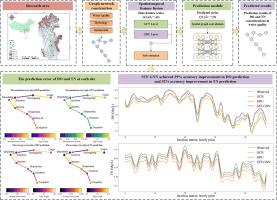Temporal and spatial feature extraction using graph neural networks for multi-point water quality prediction in river network areas
IF 12.4
1区 环境科学与生态学
Q1 ENGINEERING, ENVIRONMENTAL
引用次数: 0
Abstract
Deep learning methods have demonstrated strong capabilities in capturing nonlinear relationships for water quality prediction, yet existing studies predominantly focus on individual monitoring sites while neglecting pollutant spatial dynamics. To address this limitation, a Spatio-Temporal Feature Graph Neural Network (STF-GNN) was proposed, which integrated graph convolutional networks (GCN), gated recurrent units (GRU), and self-attention mechanisms to explicitly model multi-scale spatiotemporal dependencies among distributed monitoring stations. By representing stations as graph nodes with adjacency relationships, STF-GNN could simultaneously extract spatial topological features and temporal evolution patterns from multivariate time series data. Experimental results demonstrated superior performance in dissolved oxygen (DO) and total nitrogen (TN) prediction, achieving RMSE values of 0.233 (DO) and 0.033 (TN), outperforming baseline models by 36.54–161.47 % in accuracy. Cross-basin validations revealed robust generalization capabilities of the established model, maintaining maximum relative errors below 0.639 (DO) and 0.606 (TN) without site-specific customization. Notably, the model achieved 88 % peak-valley synchronization at untrained station, demonstrating strong anti-interference ability against unseen environmental variations. Ablation studies confirmed the necessity of both spatial and temporal modules, with their omission causing significant accuracy declines (12.07–19.25 %). These findings highlighted the critical roles of both spatial and temporal feature extraction in improving predictive performance of the model. The work can provide a theoretically grounded framework for spatially-aware water quality prediction, supporting enhanced environmental monitoring strategies.


基于图神经网络的河网区多点水质预测时空特征提取
深度学习在捕获非线性关系进行水质预测方面已经显示出强大的能力,但现有的研究主要集中在单个监测点,而忽略了污染物的空间动态。为了解决这一限制,提出了一种时空特征图神经网络(STF-GNN),该网络集成了图卷积网络(GCN)、门控循环单元(GRU)和自关注机制,以明确地模拟分布式监测站之间的多尺度时空依赖关系。通过将站点表示为具有邻接关系的图节点,STF-GNN可以同时从多变量时间序列数据中提取空间拓扑特征和时间演化模式。实验结果表明,溶解氧(DO)和总氮(TN)预测的RMSE值分别为0.233 (DO)和0.033 (TN),准确度优于基线模型36.54 ~ 161.47%。跨流域验证表明,所建模型具有较强的泛化能力,在没有特定站点定制的情况下,最大相对误差保持在0.639 (DO)和0.606 (TN)以下。值得注意的是,该模型在未经训练的站点上实现了88%的峰谷同步,对未知环境变化具有较强的抗干扰能力。消融研究证实了空间和时间模块的必要性,它们的缺失导致精度显著下降(18.09-19.25%)。这些发现突出了时空特征提取在提高模型预测性能方面的关键作用。这项工作可以为空间感知水质预测提供理论基础框架,支持加强环境监测策略。
本文章由计算机程序翻译,如有差异,请以英文原文为准。
求助全文
约1分钟内获得全文
求助全文
来源期刊

Water Research
环境科学-工程:环境
CiteScore
20.80
自引率
9.40%
发文量
1307
审稿时长
38 days
期刊介绍:
Water Research, along with its open access companion journal Water Research X, serves as a platform for publishing original research papers covering various aspects of the science and technology related to the anthropogenic water cycle, water quality, and its management worldwide. The audience targeted by the journal comprises biologists, chemical engineers, chemists, civil engineers, environmental engineers, limnologists, and microbiologists. The scope of the journal include:
•Treatment processes for water and wastewaters (municipal, agricultural, industrial, and on-site treatment), including resource recovery and residuals management;
•Urban hydrology including sewer systems, stormwater management, and green infrastructure;
•Drinking water treatment and distribution;
•Potable and non-potable water reuse;
•Sanitation, public health, and risk assessment;
•Anaerobic digestion, solid and hazardous waste management, including source characterization and the effects and control of leachates and gaseous emissions;
•Contaminants (chemical, microbial, anthropogenic particles such as nanoparticles or microplastics) and related water quality sensing, monitoring, fate, and assessment;
•Anthropogenic impacts on inland, tidal, coastal and urban waters, focusing on surface and ground waters, and point and non-point sources of pollution;
•Environmental restoration, linked to surface water, groundwater and groundwater remediation;
•Analysis of the interfaces between sediments and water, and between water and atmosphere, focusing specifically on anthropogenic impacts;
•Mathematical modelling, systems analysis, machine learning, and beneficial use of big data related to the anthropogenic water cycle;
•Socio-economic, policy, and regulations studies.
 求助内容:
求助内容: 应助结果提醒方式:
应助结果提醒方式:


